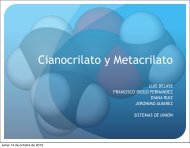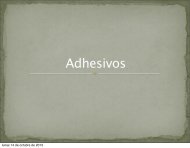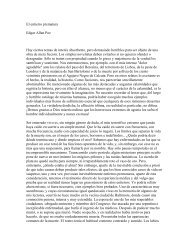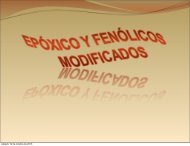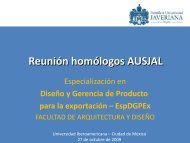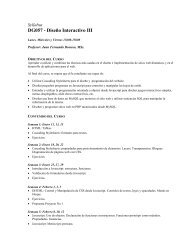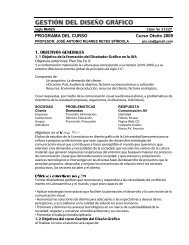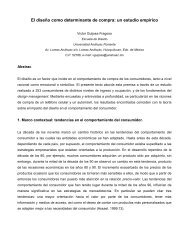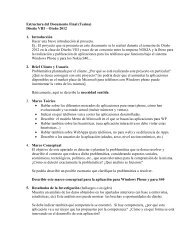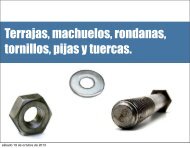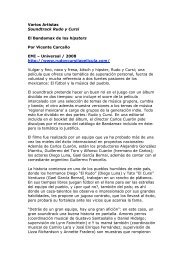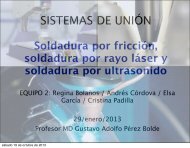descargar archivo - Departamento de Diseño - Universidad ...
descargar archivo - Departamento de Diseño - Universidad ...
descargar archivo - Departamento de Diseño - Universidad ...
You also want an ePaper? Increase the reach of your titles
YUMPU automatically turns print PDFs into web optimized ePapers that Google loves.
MX Design Conference 2011“..... how the Internet was <strong>de</strong>signed intimately affected the freedomsand controls that it has enabled. The co<strong>de</strong> of cyberspace—its architectureand the software and hardware that implement that architecture—regulateslife in cyberspace generally. Its co<strong>de</strong> is its law. Or,in the words of Electronic Frontier Foundation (EFF) cofoun<strong>de</strong>r MitchKapor, “Architecture is politics.” 1Architecture is politics and politics too often means control.The history of the world has been <strong>de</strong>fined by who controlsthe message(s). With the <strong>de</strong>velopment of the internetironicallybegun as a Cold-War effort to ensure communicationin the event of a nuclear war- we have the first platformthat is truly <strong>de</strong>mocratic. Few could have imagined theuninten<strong>de</strong>d consequences: a data revolution larger thanGutenberg’s, and with the advent of the first commercialweb browser in 1995, this revolution was ma<strong>de</strong> available toanyone with a computer and a domain name. Fifteen yearslater it’s available to anyone with a mobile phone.(4) (5) (6)(4) Lawrence Lessig’s The Future of I<strong>de</strong>as This work is licensedun<strong>de</strong>r a Creative Commons Attribution-NoncommercialLicense (US/v3.0). (Downloa<strong>de</strong>d from the website as a free pdf)(5) Clay Shirky’s subtext- ‘the power of organizing withoutorganizations’(6) Lawrence Lessig’s book: RemixRe-mix cultureThe combination of malleable digital data and open architecturehas created a culture of creative re-mixing. Mediatheorist and author Clay Shirky <strong>de</strong>scribes in his book HereComes Everyone, that:“ Communication media was between one sen<strong>de</strong>r and one recipient.This is a one-to-one pattern- I talk and you listen, then you talk andI listen. Broadcast media was between one sen<strong>de</strong>r and many recipients,and the re- cipients couldn’t talk back. This is a one-to- manypattern- I talk, and talk, and talk, and all you can do is choose to listenor tune out. The pattern we didn’t have until recently was many-tomany,where communication tools enabled group conversation.” 2All media in the past was discrete. It had proprietary formatsand separate equipment or technology. With digitaldata this has all but disappeared. On a single <strong>de</strong>vice- myMacBook Pro for example- I can create radio shows (podcasts);I can edit and broadcast movies (youtube); and I canmix music (garageband). I can distribute everything I createdirectly from my computer easily and freely. Ad- ditionallyeveryone else with the same tools can take what I’vecreated and, in most cases, edit it, alter it, amend it, and redistributeit. This capability, according to Law- rence Lessig,has created a ‘re-mix’ culture as the subtitle of his booksuggests: ‘making art and commerce thrive in the hybri<strong>de</strong>conomy.’ Of course this has also created ma- jor problemsrelated to copyright. Lessig and other legal scholars havebeen actively writing about these issues because the lawcan’t <strong>de</strong>al with the materials alone (mu- sic, image, text, filmand so on) without consi<strong>de</strong>ring the ‘co<strong>de</strong>’ that materializesthem and allows for re-mixing.1 ibid, p. 332 Here Comes Everybody, Clay Shirky, Penguin (2008) p. 86‐87(7)(7) Wikipedia combines the power of the ‘wiki’ (Hawiian forquick) with an in- terested public.Mass collaborationBuilding upon and altering the i<strong>de</strong>as of other peers hasbecome an essential part of the digital revolution’s rapidgrowth and expansion of knowledge. This mass collaborationapplies today as easily to software <strong>de</strong>velopment as itdoes to the collective effort to build an on-line encyclopedia(Wikipedia and countless other ‘wikis’), the on-linesharing of instruction sets to build, alter, or modify newand existing objects (instructables.com), and the remixingof musical source co<strong>de</strong> from downloadable files (Nine InchNails). The open innovation that open source has inspiredhas captured the imagination of business writers, legalscholars, scientists, <strong>de</strong>signers, and even manufacturers (toname but a few). Many are proclaiming a completely newparadigm has emerged for approaching problems andcollaboratively <strong>de</strong>veloping solutions that will change theway everything is eventually done.Authors like Don Tapscott (Wikinomics and Macrowikinomics)see the application of mass collaboration as thepanacea to so many of our contemporary ills while othercommentators like Nicholas Carr (The Shallows: What theInternet Is Doing to Our Brains, The Big Switch) is morecautious. Yocai Benkler (The Wealth of Networks) andLawrence Lessig (Co<strong>de</strong>, The Future of I<strong>de</strong>as, Free Culture,Remix, etc.) not only see this as an essential part of innovationbut have also used the technology of the internet to186



